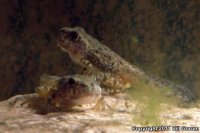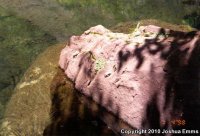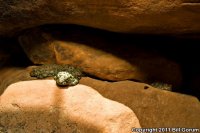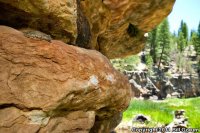| Range: |
 |
| Other Names: |
|
| Description: |
The canyon treefrog is a relatively small (to about 2.2 inches), rough-skinned frog with large adhesive toe pads for climbing. It is a gray, tan, or olive frog typically with green or gray blotches or spots, but sometimes lacking spots. It lacks a dark stripe through the eye, and the toes on the hind feet are webbed. Adult males have a dark throat patch and frogs often have considerable yellow or orange in the groin and inner thighs. Tadpoles typically have dark spots and patches, and become speckled with golden or bronze coloration as they mature. They grow to about 1.5 inches prior to metamorphosis. |
| Similar Species: |
The Arizona Treefrog can be distinguished based on color. It is bright green with a lateral stripe extending from the snout posteriorly to the shoulder. |
| Habitat: |
As its name implies, it is a frog of canyons and arroyos, particularly rocky, intermittent or permanent stream courses. Canyon treefrogs are found from the desert's edge to high in the mountains where it occurs in chaparral, pinyon-juniper, oak, pine-oak, and mixed conifer woodlands. They are sometimes been found in montane talus slopes, apparently far from water. |
| Behavior: |
On warm evenings they can be found at or near the water's edge, but during the day or dry periods they take refuge in rock crevices or on rock faces, or less commonly on or in trees near the canyon bottom. In the spring or summer it is not uncommon to find several of these frogs crowded together, lining a shallow rock crevice. In such crevices or on granite boulders, they are particularly well camouflaged. At dusk they climb down from their day perch and move towards water to forage or breed. They often return to the same day perch for several or many days in succession. |
| Hibernation: |
|
| Reproduction: |
Breeding occurs both in the spring and during the early part of the summer monsoon. The call, given by the male, is a loud, rattling series of short trills that sound like they are coming from inside a tin can. The call is surprisingly loud given the small size of this frog. Calls are heard mostly after dark, but some individuals will call during day, particularly during or after a rainstorm. One hundred or more eggs are laid in a mass that may be free-floating or attached to vegetation. The eggs hatch in less than two weeks and tadpoles typically metamorphose in 45-75 days. Eggs deposited late in the breeding season may overwinter. |
| Diet: |
Canyon treefrogs feed upon a number of small invertebrates, such as beetles, caddisflies, and true bugs. |
Adapted from account on reptilesofaz.org
Sources:

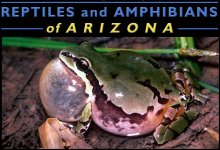
|


